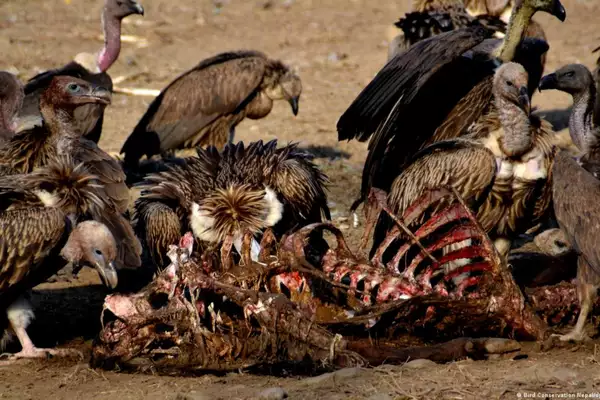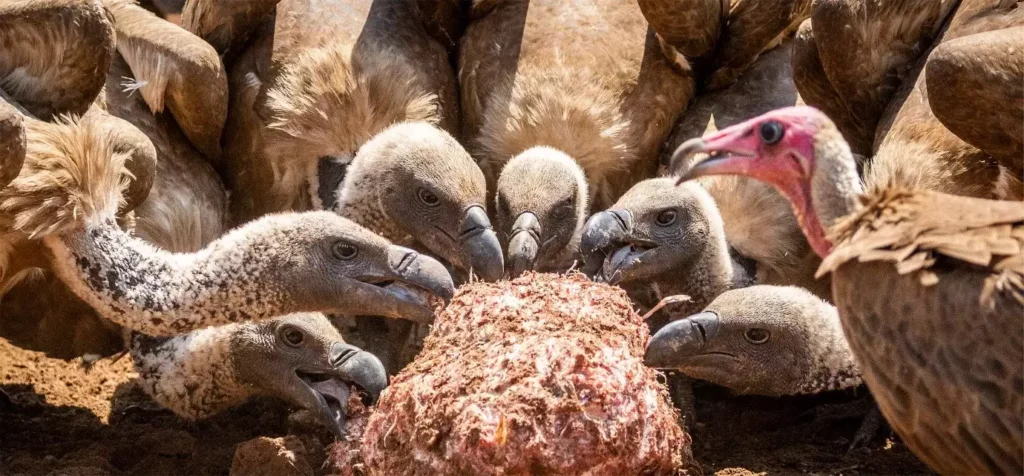The ‘Vulture Restaurant‘ was recently established in Koderma district, Jharkhand, to revive the dwindling population of vultures, a bird species crucial for ecological balance.
About the Vulture restaurant or Giddha Bhojanalaya:
- The ‘Vulture Restaurant‘ is an initiative to address the declining vulture population, by reducing the decline of vulture caused due to diclofenac use in livestock.
- It is a site where carrion, decaying flesh from dead animals, is deposited in order to be consumed by vultures, and is also referred to as supplemental feeding or provisioning.
- Diclofenac enriched carcass leads to kidney failure in the birds.
- The prevalence of diclofenac had resulted in the disappearance of vultures in Koderma for almost 2 decades until their resurgence in 2019.
- It serves as a demarcated feeding site, with carcasses from goshalas and municipalities are offered as food to scavenger birds.
- It can decrease vulture mortality events resulting from starvation, food contamination, and human contact.
- Bamboo fencing is done at the feeding site in order to prevent other animals like dogs or jackals from accessing vulture food, ensuring the birds’ exclusive access.
- A vulture interpretation and rescue centre, along with geo-tagging for monitoring, can help enhance conservation efforts.
Other Threats:
- Collision with power lines, electrocution, injury by kite strings, and poison baits pose additional risks to vultures.
Conservation status:
- The Wildlife Protection Act: Schedule I
- IUCN: Criticallyendangered
Current Status:
- Vulture species such as- Gyps Bengalensis, Gyps Indicus, Gyps Himalayensis, and the critically endangered Egyptian Vulture, has seen a positive trend in 2022 baseline survey.
- The Jharkhand Forest Department designates a 100-km radius from the center of Hazaribag as a safe zone for vultures.
Types of Vultures in India:
- In the 1980s, India housed around 4 crore vultures, by 2007, the population plummeted to less than a lakh.
Indian Vulture (Gyps indicus):
- Features: Medium-sized raptor with white feathers, dark torso, and prominent white patch on the neck.
- Distribution: Extended from southeastern Pakistan to South India and to Indochina and the northern Malay Peninsula in the east
- Alias: Long-billed Vulture
- Habitat: Found in forests, grasslands, and shrublands; observed near human-occupied spaces.
- IUCN Status: Critically Endangered
Slender-billed Vulture (Gyps tenuirostris):
- An Old-World vulture species native to sub-Himalayan regions and Southeast Asia.
- Description: A mid-sized vulture that is mostly grey with a pale rump and grey undertail coverts.
- The neck is long, bare, skinny and black.
- The black head is angular and narrow with the dark bill appearing narrow midway.
- Distribution: Ranges from the Gangetic plain north, west to Himachal Pradesh, south potentially as far as northern Odisha, and east through Assam.
- Alias: Himalayan Long-billed Vulture
- Habitat: Prefers grasslands and forests in northern India; characterized by long, slender necks and pale underparts.
- IUCN Status: Critically Endangered
Egyptian Vulture (Neophron percnopterus):
- A small Old World vulture, that has yellow heads and white-black plumage.
- Distribution: The Iberian Peninsula, North Africa, West Asia and India.
- Alias: White Scavenger Vulture, Pharaoh’s Chicken
- Habitat: Found in open areas, near river banks, and large garbage dump sites.
- IUCN Status: Endangered
Red-headed Vulture (Sarcogyps calvus):
- A medium sized Old World vulture mainly found in the Indian subcontinent, with small disjunct populations in some parts of Southeast Asia.
- Description: Prominent naked head, deep-red to orange in the adult, paler red in the juvenile.
- It has a black body with pale grey band at the base of the flight feathers.
- Males have a paler, whitish iris, whilst in females it is dark brown.
- Distribution: China, India, Bangladesh, Cambodia, Laos, Myanmar, Nepal, Vietnam
- Alias: Asian King Vulture, Indian Black Vulture
- Habitat: Distributed throughout India, preferring open areas and semi-deserts; medium-sized with distinct bare, red heads.
- IUCN Status: Critically Endangered
White-rumped Vulture (Gyps bengalensis):
- A medium-sized Old World vulture native to South and Southeast Asia.
- Description: Unfeathered head and neck, very broad wings, and short tail feathers.
- It has a white neck ruff.
- The body is black and the secondaries are silvery grey.
- The head is tinged in pink and bill is silvery with dark ceres.
- Distribution: Northern and central India, Pakistan, Nepal, Bangladesh and southeast Asia.
- Alias: Indian White-backed Vulture
- Habitat: Commonly seen near human-occupied spaces; medium-sized with white neck ruffs and black-brown plumage.
- IUCN Status: Critically Endangered
Griffon Vulture (Gyps fulvus):
- A large Old-World vulture having white head, very broad wings and short tail feathers.
- Description: It has a white neck ruff and yellow bill.
- The buff body and wing coverts contrast with the dark flight feathers.
- Alias: Eurasian Griffon
- Habitat: Mainly in northern and northwestern parts of India.
- IUCN Status: Least Concern
Himalayan Vulture (Gyps himalayensis):
- Alias: Himalayan Griffon
- Description: Pale plumage, distinct stout bills, and white heads.
- Habitat: Found in the Himalayan Mountain range including Tibetan Plateau.
- Distribution: Kazakhstan, Uzbekistan, Kyrgyzstan, Tajikistan, Afghanistan and Iran to Pakistan to India, Nepal, Bhutan to western China and Mongolia
- IUCN Status: Near Threatened
Cinereous Vulture (Aegypius monachus):
- A large raptor in the family Accipitridae and distributed through much of temperate Eurasia.
- Alias: Black Vulture, Monk Vulture
- Description: Bare heads, dark plumage, and large beaks
- Habitat: Mainly in northern parts of India including the Himalayas and the adjoining Tibetan Plateau.
- IUCN Status: Near Threatened
Bearded Vulture (Gypaetus barbatus):
- It is a very large bird of prey in the monotypic genus Gypaetus.
- Alias: Lammergeier, Ossifrage
- Description: It has long, narrow wings, wedge-shaped tail, and does not have a bald head.
- The adult is mostly dark gray, rusty, and whitish in color, with creamy-coloured forehead against a black band across the eyes.
- Habitat: Rocky regions and mountains above 1000 meters; red rings around eyes, long tail feathers, and rust-like coloration.
- IUCN Status: Near Threatened

[ref-India bird watching]

![[ref-India bird watching]](https://iastoppers.in/wp-content/uploads/2024/06/bearded-ias-toppers-1024x318.png)
Vulture Conservation Initiatives:
World:
- SAVE (Saving Asia’s Vultures from Extinction) Program: This is an international initiative that involves collaboration between organizations such as the Royal Society for the Protection of Birds (RSPB), BirdLife International, and BNHS for conservation actions across South Asia to save vultures from extinction.
India:
- Vulture Conservation Breeding Centre (VCBC): Established in Pinjore, Haryana, in 2001, this center actively works to prevent the extinction of Indian, White-rumped, and Slender-billed Vultures.
- Jorbeer Conservation Reserve: Located in Bikaner, Rajasthan, it serves as a dedicated vulture sanctuary, providing a safe space for vultures to feed on animal carcasses.
- Vulture Safe Zones (VSZ): Bombay Natural History Society (BNHS) has implemented VSZ to protect Gyps vultures and increase awareness about the dangers of diclofenac.
- India’s Action Plan for Vulture Conservation 2020-2025: Lays down measures including conservation breeding programs, population monitoring, and the establishment of rescue centers.
- Jatayu Conservation Breeding Center: Type of VCBC established in Bir Shikargah Wildlife Sanctuary, Haryana, known as the Jatayu Conservation Breeding Center.
Ref: Source
| UPSC IAS Preparation Resources | |
| Current Affairs Analysis | Topperspedia |
| GS Shots | Simply Explained |
| Daily Flash Cards | Daily Quiz |



